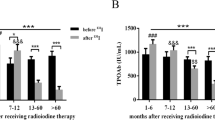Abstract
In a survey of patients having anti-TSH antibody (TSH Ab), data from 167 subjects were collected from 8 Japanese Institutions. They were divided into a high TSH Ab group consisting of 63 cases; since the means of assay was via a subnormal thyrotropin binding inhibitor immunoglobulin (TBII) assay, this group had TBII values less than −20%. An additional low TSH Ab group was made up of 104 cases. Out of a total of 11,211 patients, the incidence of TSH Ab for the high and low groups were 0.57% and 13.4%, respectively. More than 95% of these TSH Ab carriers had Graves’ disease or some other autoimmune thyroid disorder, and anti-thyroglobulin and anti-thyroid microsomal antibodies were detected similarly in both groups. It was significant that TSH receptor antibodies could also be detected in both groups, namely, thyroid stimulating antibody and long acting thyroid stimulator (LATS) in 4 of 9 patients in the high TSH Ab group and TBII in 55 of 104 in the low TSH Ab group, respectively. The high TSH Ab levels tended to persist, but 26% of cases showed disappearance or appearance of the antibody during the observation period. In one Graves’ patient, a moderate TBII activity (64.2%) was followed by markedly elevated TSH Ab (TBII: −83.4%) within 2 months. The TSH Ab in the low TSH Ab group disappeared in most cases. Also, fluctuations in TSH Ab did not always parallel those seen for TBII and reciprocal fluctuation pattern (transient or otherwise) were observed in 33%. In conclusion, anti-TSH antibody is produced frequently in patients with either Graves’ disease or some other autoimmune thyroid disorder. Interrelationship between this antibody and the TSH receptor antibody was not evident, and the reason for, and significance of, such antibody production remain to be elucidated.
Similar content being viewed by others
References
Kajita Y., Nakajima Y., Ishida M., Ochi Y., Miyazaki T., Hachiya T., Ijichi H. Characteristics of auto-antibodies to bovine TSH in the serum of two patients with Graves’ disease. Acta Endocrinol. (Copenh.) 104: 423, 1983.
Akamizu T., Ishii H., Mori T., Ishihara T., Ikekubo K., Imura H. Abnormal thyrotropin-binding immunoglobulins in two patients with Graves’ disease. J. Clin. Endocrinol. Metab. 59: 240, 1984.
Biro J. Specific binding of thyroid-stimulating hormone by human serum globulins. J. Endocrinol. 88: 39, 1981.
Beall G.N., Kruger S.R. Binding of [125I]human TSH by gammaglobulins of sera containing thyroid-stimulating immunoglobulin (TSI). Life Sci. 32: 77, 1983.
Raines K.B., Baker J.R. Jr., Lukes Y.G., Wartofsky L., Burman K.D. Antithyrotropin antibodies in the sera of Graves’ disease patients. J. Clin. Endocrinol. Metab. 61: 217, 1985.
Eto S., Fujihira T., Ohnami S., Suzuki H. Autoantibody to bovine TSH in Hashimoto’s thyroiditis. Lancet 1: 520, 1984.
Iitaka M., Tanikawa T., Sakatsume Y., Yanagisawa Y., HaraY., Ishii J. Interference with thyrotropin receptor antibody determination by a spuriously occurring anti-bovine TSH antibody. Acta Endocrinol. (Copenh.) 112: 197, 1986.
Akamizu T., Mori T., Yokota T., Nakamura H., Imura H. Clinical significance of elevated labeled TSH binding (LTB) activity in sera of patients with Graves’ disease and other thyroid disorders. J. Endocrinol. Invest. 10: 459, 1987.
Islam M.N., Pepper B.M., Briones-Urbina R., Farid N.R. Biological activity of anti-thyrotropin anti-idiotypic antibody. Eur. J. Immunol. 13: 57, 1983.
Baker J.R.Jr., Lukes Y.G., Burman K.D. Production, isolation and characterization of rabbit anti-idiotypic antibodies directed against human antithyrotropin receptor antibodies. J. Clin. Invest. 74: 488, 1984.
Burman K.D., Baker J.R.Jr. Immune mechanism in Graves’ disease. Endocr. Rev. 5: 200, 1985.
Akamizu T., Mori T., Kasagi K., Kosugi S., Miyamoto M., Nishino K., Sugawa H., Yokota T., Nakamura H., Konishi J., Imura H. Anti-TSH antibody with high specificity to human TSH in sera from a patient with Graves’ disease: its isolation from, and interaction with. TSH receptor antibodies. Clin. Endocrinol. (Oxf.) 26: 311, 1987.
Shewring G., Smith B.R. An improved radioreceptor assay for TSH receptor antibodies. Clin. Endocrinol. (Oxf.) 17: 409, 1982.
Akamizu T., Bito S., Ishihara T., Sawada K., Ikekubo K., Mori T. Fundamental and clinical studies of TBII kit. Clin. Endocrinol. (Tokyo) 32: 195, 1984, (Japanese).
Akamizu T., Mori T., Ishii H., Yokota T., Nakamura H., Imura H. Incidence and specificities of labeled TSH binding immunoglobulins (LTB-Igs) in patients with Graves’ disease and other thyroid disorders. Jpn. J. Med. 25: 13, 1986.
Kasagi K., Konishi J., Iida Y., Ikekubo K., Mori T., Kuma K., Torizuka K. A new in vitro assay for human thyroid stimulator using cultured thyroid cells: effect of sodium chloride on adenosine 3′, 5′-monophosphate increase. J. Clin. Endocrinol. Metab. 54: 108, 1982.
McKenzie J.M. The long-acting thyroid stimulator: its role in Graves’ disease. Recent Prog. Horm. Res. 23: 3, 1967.
Tokunaga K., Tuji T. Distribution of histocompatibility lymphocytic antigens (in Japanese). Nipponrinsho 42: 335, 1984 (Japanese).
Uno H., Sasazuki T., Tamai H., Matsumoto H. Two major genes, linked to HLA and Gm, control susceptibility to Graves’ disease. Nature 292: 768, 1981.
Azuma Y., Sakurami T., Ueno Y., Ohishi M., Saji H., Terasaki P.I., Park M.S. HLA-DR antigens in Japanese with Hashimoto’s thyroiditis and Graves’ disease. Endocrinol. Jpn. 29: 423, 1982.
Author information
Authors and Affiliations
Rights and permissions
About this article
Cite this article
Akamizu, T., Mori, T., Imura, H. et al. Clinical significance of anti-TSH antibody in sera from patients with Graves’ disease and other thyroid disorders. J Endocrinol Invest 12, 483–488 (1989). https://doi.org/10.1007/BF03350740
Received:
Accepted:
Published:
Issue Date:
DOI: https://doi.org/10.1007/BF03350740




